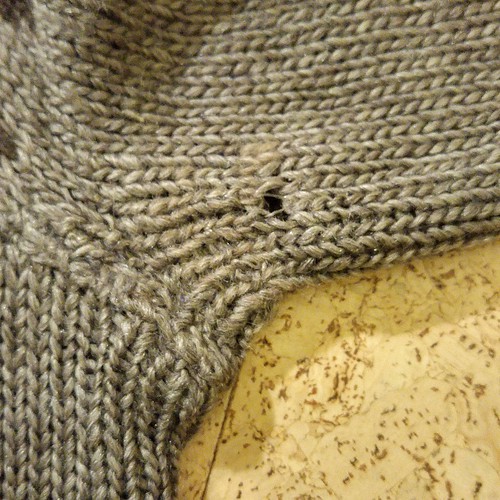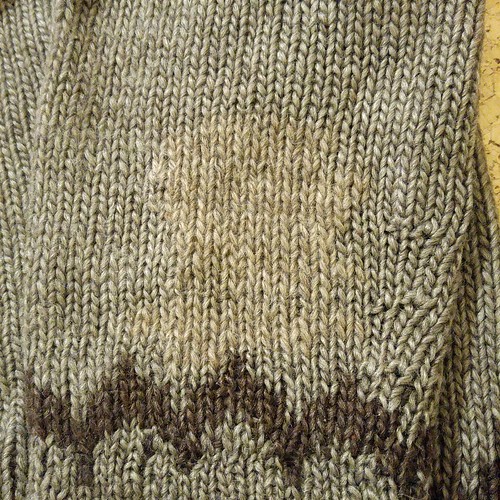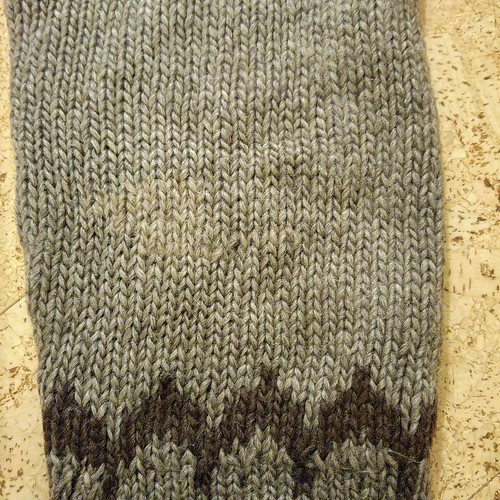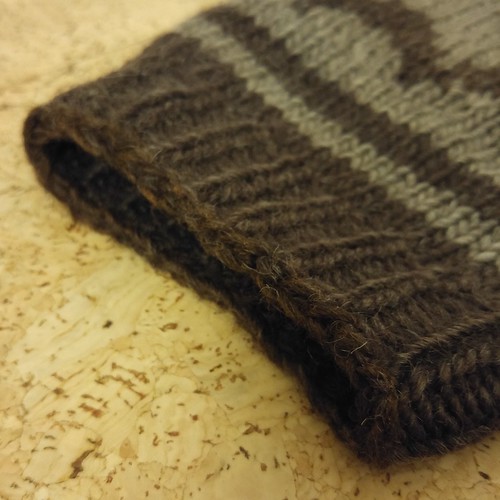This sweater is one of the repair jobs that taught me that lesson.
This beauty was brought in by a local gentleman along with two other sweaters. Um, about a year ago. Oops. They were all knit by his Mother years ago, and she's since passed away. This is an important job. The first sweater was an easy repair - a couple of broken strands and some mostly-matching yarn to fix the hole. This is the second sweater, and boy did I under-estimate the work needed on her.
There are no before pictures, but there were quite a few holes in the sleeves. Mostly at the elbows, but while repairing those, I noticed how thin the fabric was getting around the holes, and on other sections of the sleeves. You can maybe see my patches above and below.
Maybe because I'm damn good at these sort of repairs - patching large sections and creating new fabric. Though there's only so much I can do to match the yarn colour.
 |
| I only noticed the hole while taking these photos. You can sort of see a patch I started months ago. Obviously I didn't finish the section back then. |
The last section to be repaired (other than a few wee holes around the colourwork at the bottom of the sweater) was the ratty hem. I wish I'd taken a photo of it before hand, or even from a few hours ago. I'd say about 2/3rds of the bottom hem were falling apart. Mostly just on the cast-on row, but there were a few sections with broken strands a few rows down.
It took a few tries, and abandoning the hem to practice on the sleeve hems, but I managed to work out how to do a sewn reinforcement for most of the edge, with a few areas where I had to build up the fabric by picking up clean stitches and knitting the fabric up, then bind-off the edge. My yarn is a bit more red than the sweater yarn, so you can kind of see what I'm talking in these photos, especially the one below that shows one section that I had to build up the fabric.
The sweater is having a bath right now. Ye gods, I didn't realize how dirty this sweater is, poor thing. I was hoping to take it to work tomorrow because I think he's coming by then, but I feel like I should leave the sweater in the bath overnight. I added a bunch of moisturizing conditioner to try to add some moisture back into the fabric. Don't know if it'll work, but it can't hurt.
Oh, and here's a shot of the yoke colourwork. She really is a lovely sweater. Despite the time and effort of this repair, I'm glad I could give it some life!
Do you ever tackle any big repair jobs? I know I didn't before this.








Wow, you have done a great job. I didn’t even know thise knids of repairs were possible without darning. Doyou pick up and knit in some clever way? Or all with a needle?
ReplyDeleteI didn’t know you could soak wool for so long. Lots of stuff I didn’t know! Your blog is educational!
Gorgeous sweater.
I mostly do these repairs by duplicate stitching over weak or broken strand sections, and it's a good technique for sealing up small holes.
DeleteIf there's a big gaping hole though, that's when it gets a bit trickier. I'll pick up clean, undamaged stitches at the base of the hole (which often involves dropping down a couple more rows), then simultaneously knit up (picking up stitches where the hole gets wider, if necessary) and anchoring into the surrounding fabric via duplicate stitching. It can be time consuming and I'm not a fan of doing it, but it's so satisfying to see a ragged hole turn into whole fabric. And even better to see the delight on the owner's face when their precious sweater is wearable again.
I'm glad you learn things from my blog! Thanks for telling me, that made me smile!
You're a saint. I'd seriously rather stick a knitting needle in my eye than repair work. Same goes for sewing actually. I'd almost rather start new than pick out a bunch of stitches sometimes :)
ReplyDeleteHaha! Before taking over the shop, I totally would've agreed with you. I sometimes still do because ugh so much else I'd rather do. But it really is sad to see a broken sweater, and there's not many people in town willing to do repair work.
DeleteActually, I'm not sure if there's anywhere else that would.
Very nice work.
ReplyDeleteGod bless.
Thanks!
Delete